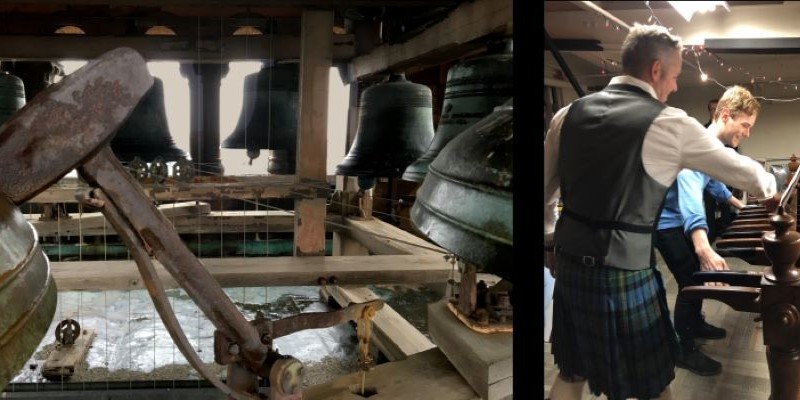The countdown is on until Friday, October 30th when the Altgeld bells will ring their official centennial. That’s 100 years to the day since the 15 bells were mounted and first played. At 3 p.m., chimesmaster Tina Horton will perform much of the same concert from that homecoming in 1920, with a tantalizing twist — a dueling performance of bells and band, with 50 members of the Marching Illini positioned around the Alma Mater. They’ll play a first-ever call and response of Illinois Loyalty. Don’t miss the fun; it will stream live both here and here. In-person attendance is discouraged; no crowds allowed.
Following the concert, you can attend a webinar, Celebrating a Campus Landmark: The History and Impact of Altgeld Hall, part of LAS Impact Week. It’s intended for alumni/ae but open to everyone; register here to learn about the history of the bells and the building, and the plans for its upcoming renovation.
Daily concerts from October 25th through 29th, at 12:50 p.m. and 3:50 p.m., will profile music from each decade of the century. The full schedule is here.
The bittersweet note is that this will be the last major concert for the chimes during the renovations of Altgeld Hall. The tower will close for structural work and the bells silenced as early as November. The complete restoration is planned to wrap up in 2025. Not since the 1950s have the bells been quiet so long; then it took much of the decade to restore rusted cables and worn out mechanisms that had no attention since their installation. Again in 2017-18 the chime was given significant restoration.
The centennial celebrations will soften that blow. The bells players have organized a first-ever composition contest, inviting submissions in two categories: either an original composition or an arrangement from a BIPOC (Black, Indigenous, Person of Color) composer, artist, or songwriter. The winning pieces will be performed at the “Concert for the Future of the Chimes” on Saturday, October 31st; you can listen to them all here.
The centennial has become a campus-wide gala — something to celebrate when so much is Covid-contained. The deans of LAS and FAA seized the chance to collaborate, joining with the School of Music and the Department of Mathematics. It was an inspiration to invite the Marching Illini to strut their stuff in a season when they can’t otherwise. Director Barry Houser opened the opportunity first to seniors, since this is likely to be their last hurrah in public. Campus communications director Brad Petersen had his team develop a website for the occasion, with a push by development directors Evan Tammen of LAS, David Allen of Music, and an across-campus committee. Bellsplayer and undergraduate Quarrie McGuire designed logos for both the centennial and the composition contest.
Horton, a Filipina-American and the first person of color in the position, will open the week-long celebration at 2:30 pm on Sunday, October 25th with a set of songs in honor of Filipino American History Month. That and other concerts will livestream on the Altegeld Chimes FB page. She has focused on expanding the repertoire of bells tunes to represent the breadth of cultures across campus. Her summer concert series was a strong statement of that effort, “Amplify their Voices: A Celebration of BIPOC Music.” It kicked off with the first-ever Juneteenth concert and ended with a duo between her and Albert Lau on October 1st for the East Asian Mid-Autumn Festival. She knows that songs that catch the attention of the entire campus may in turn widen the bells players to more BIPOC representation.
Altgeld Hall opened in 1897 as the University Library, designed by architecture luminary Nathan Ricker, with James White. When the collections outgrew the space, it became the home of the College of Law in 1927, and in 1956, the Math Department. Since 1970 it has been listed on the National Register of Historic Places. The planned renovation will restore many of the glorious details, including the glass dome that arced over the library until 1942. It has been painstakingly reconceived from photographs by Mathematics office manager Jane Bergman.
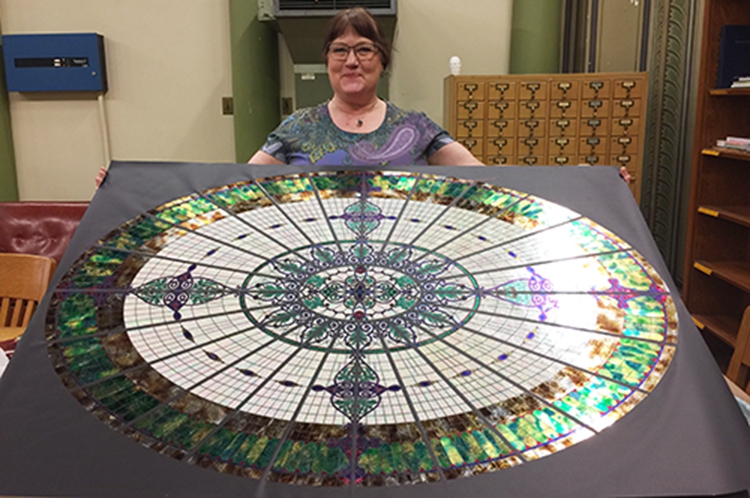
Photo from College of LAS website.
Ricker intended from the start for the tower to hold bells, but there was no plan until the Class of 1914 pondered a fitting senior class memorial gift to the university. The determined champion of the chime, then editor of the Daily Illini, was Hale Plahn “Pete” Daugherty. The competing proposals for class gift were a bust of Abraham Lincoln and an electronic scoreboard. With intense campaigning and the near unanimous support of the women of the class, the chime won out. It was an expensive prospect; the classes of 1914-21 pooled every penny they could manage and brought the total to $7,575. A boost from the U.S. School of Military Aeronautics funded thirteen bells. But Dean of Men Thomas Arkle Clark felt strongly that the chime should accommodate the full glory of Illinois Loyalty, and that required fifteen. The total, around $11,000, was scraped together and the bells cast by McShane Bell Foundry Co. of Baltimore. Of all known chimes across the country’s college campuses, and perhaps the world, our Altgeld Chimes are the only one designed specifically to play the school song.
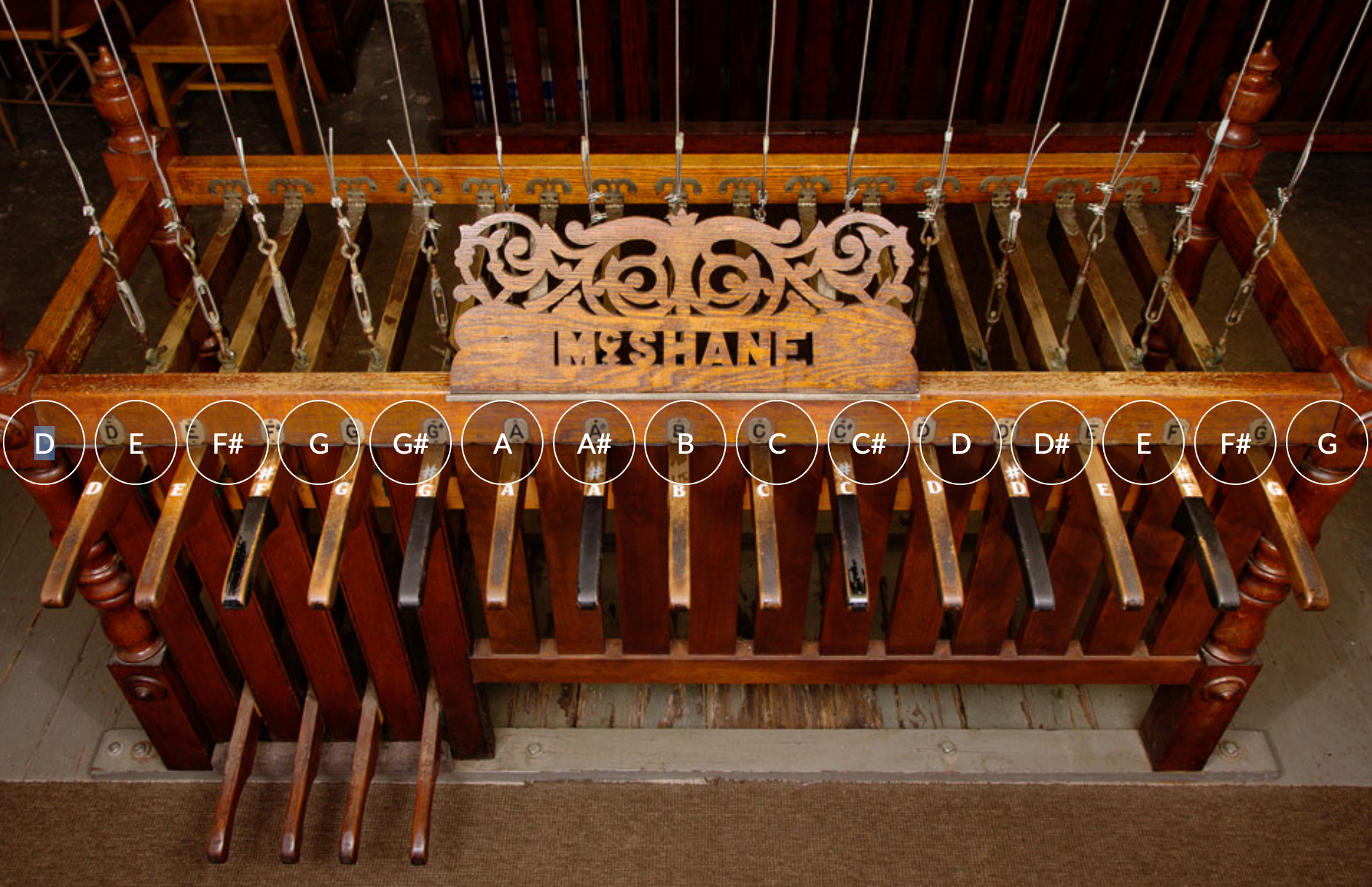
Photo by Cope Cumpston.
The chime extends from lower D to upper G, but lacks the lower D sharp and both F naturals. This presents a unique challenge; melodies often need to be artfully transposed to fit the existing notes. Try for yourself on the virtual chimesplayer.
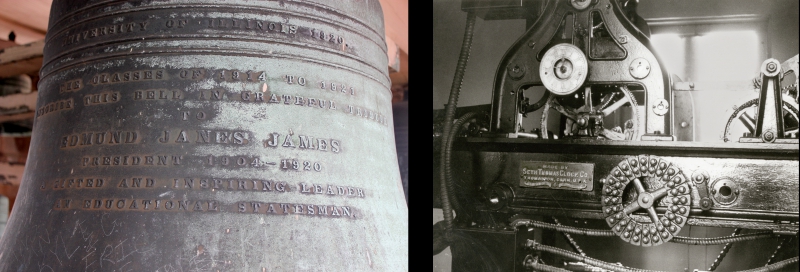
Photos by Cope Cumpston (l) and from the Altgeld Chimes archives (r).
The largest bell, affectionately known as Big Ed, is five feet across, weighing in at one and a half tons. It is dedicated to Edmund Janes James, president of the university from 1904-20. The entire set totals some seven and a half tons. In 1922 ringing of the hours and quarter hours, the traditional “Angelus,” was automated with a Seth Thomas clock mechanism, the senior class gift of 1922. That operated, with devoted attention in recent years by Bill Buesing of Facilities and Services, until 2018. An electronic system was installed during the 2017-18 renovation.
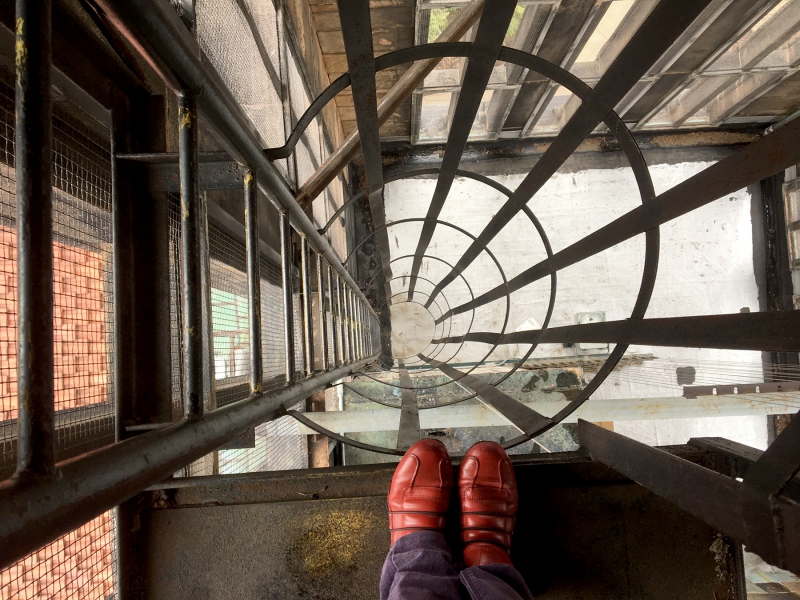
Photo by Cope Cumpston.
To meet the bells you must climb a steep staircase to a mysterious room on the fifth floor level. The keyboard is an instrument unlike any other. It consists of 15 paddles, each connected by a 60-foot steel cable to the clapper that strikes its bell. Foot pedals for the four lowest tones allow an agile player to strike three notes at once, two by hand and one by foot. For practice that doesn’t disturb the campus, there is a keyboard identical to the actual console, that operates like a xylophone.
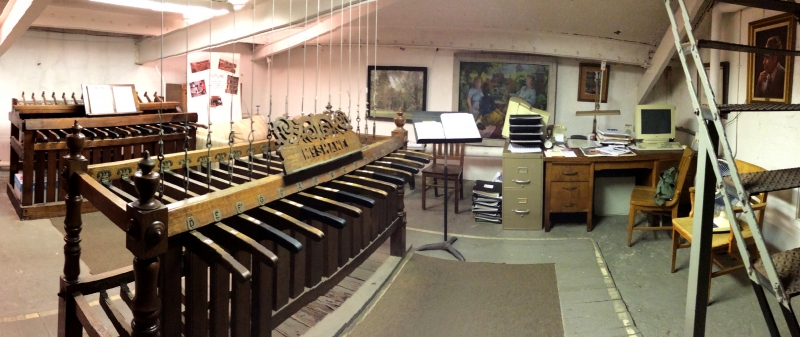
Photo by Cope Cumpston.
From the first years, a chimesmaster has directed the program. They were students until the chimes reopened in 1957 after its repairs. College of Commerce faculty Albert Marien had some experience with bells and was appointed to the position. During his long tenure, from 1958-1994, he established a regular and solid program, with its first daily concerts.
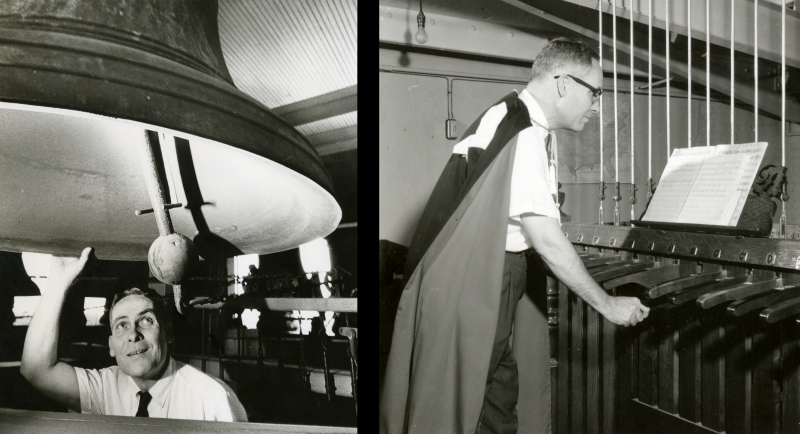
Photos of Albert Marien from Altgeld Chimes archives.
Marien aspired to bring the chimes up to the level of a full carillon, which requires at least 23 bells. He raised money to complete the set, and championed the beginnings of what resulted in the McFarland carillon on the south quad. His first intention was to install the additional bells in Altgeld, but an engineering study determined it couldn’t handle the weight. In honor of his devotion, McShane forged that critical F natural bell, but it couldn’t be installed in the existing chimes. The next time you’re at Willard Airport, look for the bell, mounted mute behind glass on the second level. The carillon was finally built, with the final contribution by alumnus Richard McFarland in honor of his wife; but it has no playing console. It is operated only by computer, based in the School of Music under the direction of composition-theory professor Stephen Taylor.
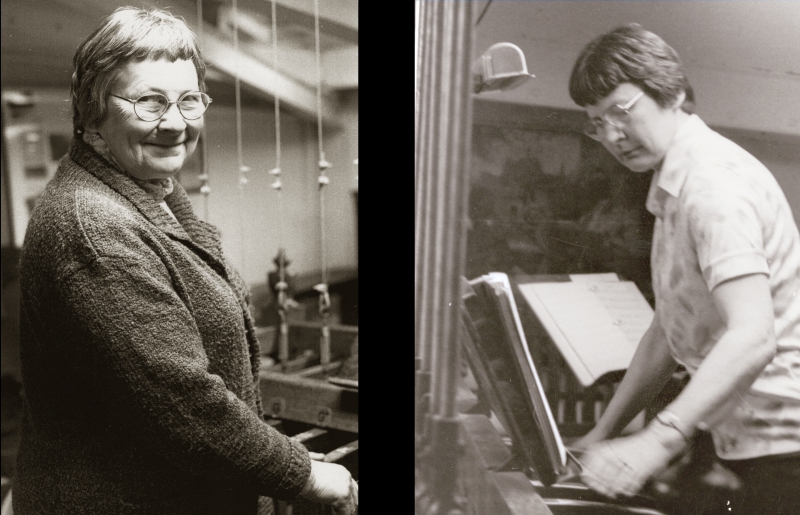
Photos of Sue Wood from Altgeld Chimes archives.
Sue Wood, PhD in Chemistry, was working as lab coordinator at Illinois Natural History Survey and then the College of Veterinary Medicine when she was first drawn to the chimes in 1971. She was more importantly a church organist with experience on the 25-bell carillon at University Lutheran Church. She and Marien became dedicated colleagues; in 1994 she took over as chimesmaster. For over forty years Wood was the daily face of the bells, delighting visitors with her tours and enthusiasm. Until 2018 it was possible to climb a vertical metal ladder up to the bells themselves; this was closed off for safety considerations. Wood trained a cadre of new players over the years — including me. Listen to Wood’s story of the program here. It gained student attention when it became an official registered student organization, with the efforts of ringers Cody Jones and Amy Liu.
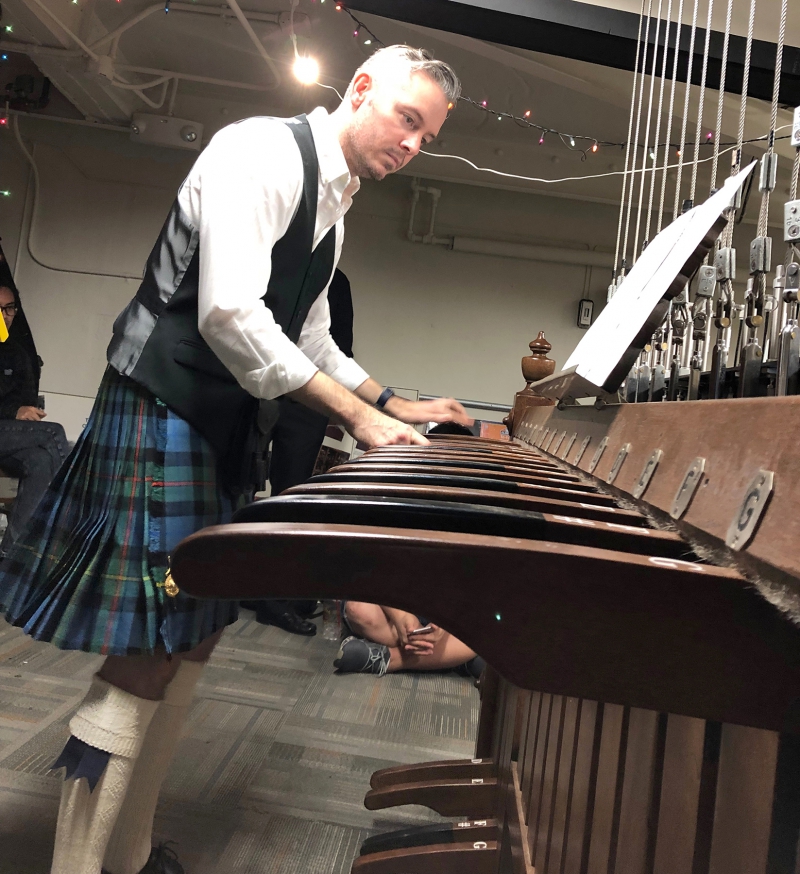
Photo of Jonathon Smith by Cope Cumpston.
Jonathon Smith was taken with the chime from his arrival on campus in 2012 as a musicology grad student. Soon after, he found his way up the staircase, met Wood, and tried his own hand. Smith has experience with other chimes and carillons across the world, but finds ours a unique experience. For him, playing the bells is truly playing the building; the physical action of playing is a kinesthetic experience, that brings both ringer and alive in a way unlike any other. He values how collegial and relaxed our program is compared to territoriality and exclusiveness he has observed on other campuses. Smith took over as chimesmaster in 2018, as a composer adding original compositions and arrangements to the music library. Particular favorites are his duets for the annual much-awaited Halloween concert.
Horton entered the musicology program as a grad student in 2015 and joined Smith at the bells. She too appreciates the ensemble nature of the program — the experience of the chimes brings people together as colleagues, leading to friendships. She took over as chimesmaster in 2019. When she realized the tower would close early in her tenure, Horton knew it was critical to document the workings of the program to ensure its continuity when the building reopens. She and Smith had compiled the complete duties of chimesmaster – leading the program is a complex exercise in teaching an unusual class.
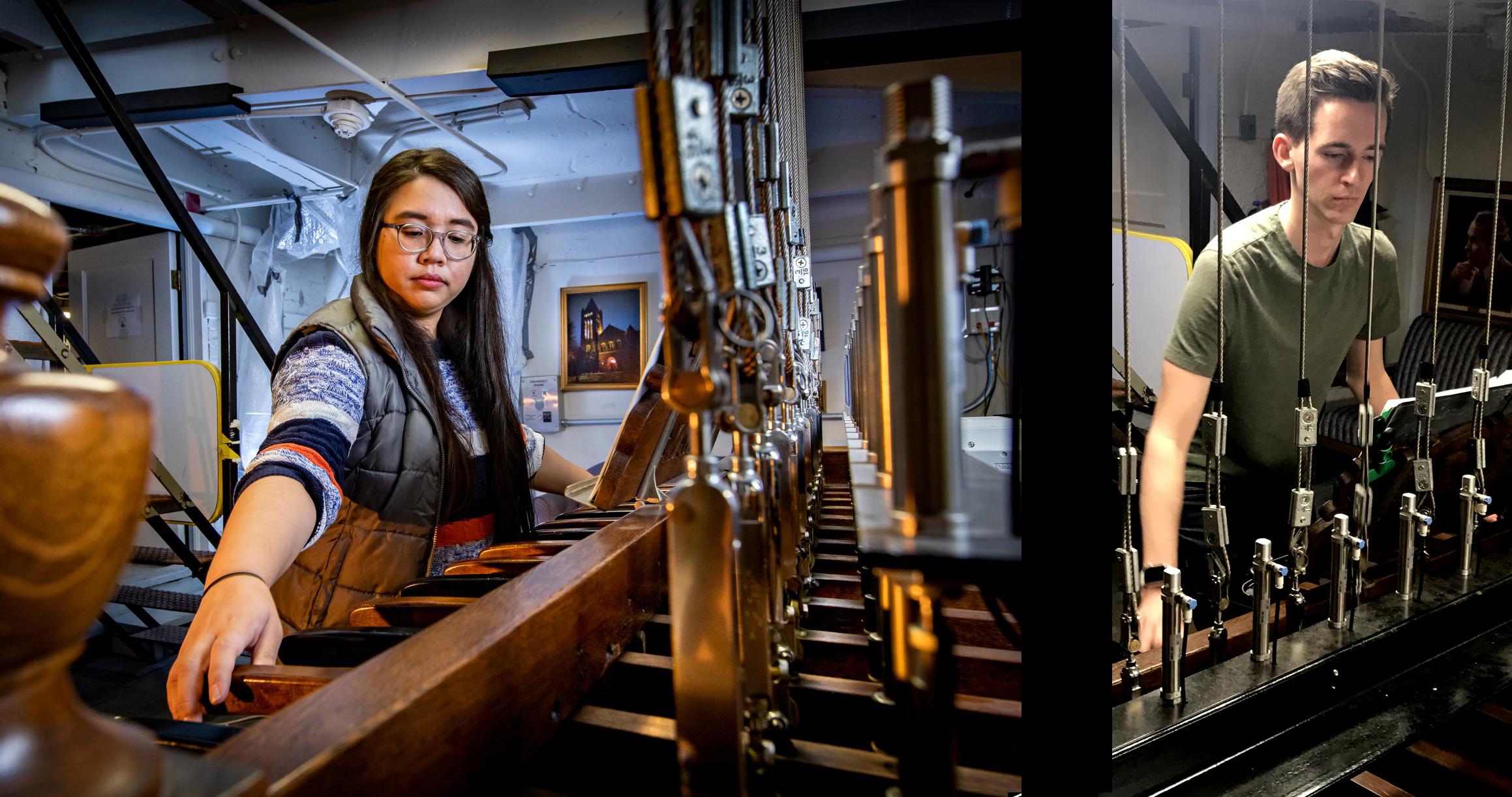
Photo of Tina Horton by Fred Zwicky from UI Public Affairs. Photo of Liam Flood by Cope Cumpston.
Particularly avid player Liam Flood helped Horton produce a complete training manual. Flood graduated last May with a degree in Chemical Engineering and now works as a data analyst in Washington, D.C., but as official historian of the bells, he is a central part of the centennial celebration plans. He and Horton have painstakingly collected archives, stories, photographs, and the workings of the program, including handwritten notebooks from 1966 listing every song played by every player in every daily concert. They have catalogued and digitized the voluminous materials, and will transfer the originals to Scott Schwartz for the Sousa Archives and Center for American Music.
Flood will present the history of the bells program at the LAS webinar following the centennial concert; he is writing a complete history of the bells, to be published in the next few years. With this year’s responsibilities, Horton brought in Michael Broussard, also studying musicology, as assistant chimesmaster.
It’s not lost on Jeremy Tyson, chair of Mathematics, that there is significant computational theory in the traditions of bells. From the 1600s, ringers devised traditions of playing as many variations on their bells as possible, known as change ringing. The combinations follow the principles of group theory. Three bells can be played in 3 x 2 x 1 combinations – 6. Four bells (factorial) allow 24, and the numbers grow dramatically from there. To play all iterations of the fifteen bells of the Altgeld tower, in one-second intervals, would take 41,000 years.
To mark the centennial, Tyson is teaching a fall seminar in the Illinois Geometry Lab that encompasses both the traditions of the Altgeld Chimes and mathematics to code the changeringing patterns. His students are exploring the subtleties of the disciplines, from the physical constraints on the bells through the mysteries of transpositions, “walks,” “Hamiltonian Cycles,” and on to more abstruse formulas. They will compose new changeringing combinations to add to the Altgeld repertoire.
And yes – the players won’t neglect the traditional Halloween concert on Saturay October 31st, a highlight of the musical year on campus. Check out the FB page for the hour the spookiest songs will toll across the night sky.








